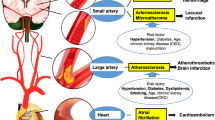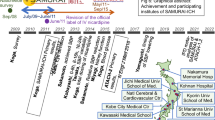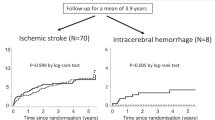Abstract
Despite the proven benefits of strict blood pressure (BP) control on primary and secondary prevention of stroke, management of acute hypertensive response in the early post-stroke period is surrounded by substantial controversy. Observational studies showed that raised BP on ischemic stroke onset is prognostically associated with excess risk for early adverse events and mortality. By contrast, randomized controlled trials and recent meta-analyses showed that although antihypertensive therapy effectively controls elevated BP in the acute stage of ischemic stroke, this BP-lowering effect is not translated into improvement in the risk of death or dependency. On this basis, acute and aggressive BP responses within 24 h of stroke onset should be avoided and antihypertensive therapy is recommended only for patients presenting with acute ischemic stroke and BP > 220/120 mmHg or those with BP > 185/110 mmHg who are eligible for therapy with intravenous tissue plasminogen activator. By contrast, recent clinical trials showed that intensive BP lowering to levels < 140 mmHg for systolic BP is safe and lowers the risk of hematoma expansion in patients with acute intra-cerebral hemorrhage and this BP target is recommended by current international guidelines. Herein, we provide an overview of randomized trials and recent meta-analyses on the management of hypertension during the acute stage of ischemic stroke. We discuss several areas of uncertainty and conclude with perspectives for future research.
This is a preview of subscription content, access via your institution
Access options
Subscribe to this journal
Receive 12 digital issues and online access to articles
$119.00 per year
only $9.92 per issue
Buy this article
- Purchase on Springer Link
- Instant access to full article PDF
Prices may be subject to local taxes which are calculated during checkout
Similar content being viewed by others
References
Britton M, Carlsson A, de Faire U. Blood pressure course in patients with acute stroke and matched controls. Stroke. 1986;17:861–4.
Qureshi AI, Ezzeddine MA, Nasar A, Suri MF, Kirmani JF, Hussein HM, et al. Prevalence of elevated blood pressure in 563,704 adult patients with stroke presenting to the ED in the United States. Am J Emerg Med. 2007;25:32–8.
Carlberg B, Asplund K, Hagg E. Factors influencing admission blood pressure levels in patients with acute stroke. Stroke. 1991;22:527–30.
Gasecki D, Coca A, Cunha P, Hering D, Manios E, Lovic D, et al. Blood pressure in acute ischemic stroke: challenges in trial interpretation and clinical management: position of the ESH Working Group on hypertension and the brain. J Hypertens. 2018;36:1212–21.
Harper G, Castleden CM, Potter JF. Factors affecting changes in blood pressure after acute stroke. Stroke. 1994;25:1726–9.
Lobanova I, Qureshi AI. Blood pressure goals in acute stroke-how low do you go? Curr Hypertens Rep. 2018;20:28.
Aslanyan S, Fazekas F, Weir CJ, Horner S, Lees KR. Effect of blood pressure during the acute period of ischemic stroke on stroke outcome: a tertiary analysis of the GAIN International Trial. Stroke. 2003;34:2420–5.
Leonardi-Bee J, Bath PM, Phillips SJ, Sandercock PA. Blood pressure and clinical outcomes in the International Stroke Trial. Stroke. 2002;33:1315–20.
Sare GM, Ali M, Shuaib A, Bath PM. Relationship between hyperacute blood pressure and outcome after ischemic stroke: data from the VISTA collaboration. Stroke. 2009;40:2098–103.
Stead LG, Gilmore RM, Decker WW, Weaver AL, Brown RD. Initial emergency department blood pressure as predictor of survival after acute ischemic stroke. Neurology. 2005;65:1179–83.
Vemmos KN, Tsivgoulis G, Spengos K, Zakopoulos N, Synetos A, Manios E, et al. U-shaped relationship between mortality and admission blood pressure in patients with acute stroke. J Intern Med. 2004;255:257–65.
ENOS Trial Investigators. Efficacy of nitric oxide, with or without continuing antihypertensive treatment, for management of high blood pressure in acute stroke (ENOS): a partial-factorial randomised controlled trial. Lancet. 2015;385:617–28.
He J, Zhang Y, Xu T, Zhao Q, Wang D, Chen CS, et al. Effects of immediate blood pressure reduction on death and major disability in patients with acute ischemic stroke: the CATIS randomized clinical trial. JAMA. 2014;311:479–89.
Bath PM, Krishnan K. Interventions for deliberately altering blood pressure in acute stroke. Cochrane Database Syst Rev. 2014;CD000039.
Ahmed N, Nasman P, Wahlgren NG. Effect of intravenous nimodipine on blood pressure and outcome after acute stroke. Stroke. 2000;31:1250–5.
Schrader J, Luders S, Kulschewski A, Berger J, Zidek W, Treib J, et al. The ACCESS study: evaluation of acute candesartan cilexetil therapy in stroke survivors. Stroke. 2003;34:1699–703.
Potter JF, Robinson TG, Ford GA, Mistri A, James M, Chernova J, et al. Controlling hypertension and hypotension immediately post-stroke (CHHIPS): a randomised, placebo-controlled, double-blind pilot trial. Lancet Neurol. 2009;8:48–56.
Bath PM, Martin RH, Palesch Y, Cotton D, Yusuf S, Sacco R, et al. Effect of telmisartan on functional outcome, recurrence, and blood pressure in patients with acute mild ischemic stroke: a PRoFESS subgroup analysis. Stroke. 2009;40:3541–6.
Robinson TG, Potter JF, Ford GA, Bulpitt CJ, Chernova J, Jagger C, et al. Effects of antihypertensive treatment after acute stroke in the Continue or Stop Post-Stroke Antihypertensives Collaborative Study (COSSACS): a prospective, randomised, open, blinded-endpoint trial. Lancet Neurol. 2010;9:767–75.
Sandset EC, Bath PM, Boysen G, Jatuzis D, Kõrv J, Lüders S, et al. The angiotensin-receptor blocker candesartan for treatment of acute stroke (SCAST): a randomised, placebo-controlled, double-blind trial. Lancet. 2011;377:741–50.
Hornslien AG, Sandset EC, Igland J, Terént A, Boysen G, Bath PM, et al. Effects of candesartan in acute stroke on vascular events during long-term follow-up: results from the Scandinavian Candesartan Acute Stroke Trial (SCAST). Int J Stroke. 2015;10:830–5.
Oh MS, Yu KH, Hong KS, Kang DW, Park JM, Bae HJ, et al. Modest blood pressure reduction with valsartan in acute ischemic stroke: a prospective, randomized, open-label, blinded-end-point trial. Int J Stroke. 2015;10:745–51.
Wang H, Tang Y, Rong X, Li H, Pan R, Wang Y, et al. Effects of early blood pressure lowering on early and long-term outcomes after acute stroke: an updated meta-analysis. PLoS ONE. 2014;9:e97917.
Lee M, Ovbiagele B, Hong KS, Wu YL, Lee JE, Rao NM, et al. Effect of blood pressure lowering in early ischemic stroke: meta-analysis. Stroke. 2015;46:1883–9.
Zhao R, Liu FD, Wang S, Peng JL, Tao XX, Zheng B, et al. Blood pressure reduction in the acute phase of an ischemic stroke does not improve short- or long-term dependency or mortality: a meta-analysis of current literature. Med (Baltim). 2015;94:e896.
Jauch EC, Saver JL, Adams HP, Bruno A, Connors JJ, Demaerschalk BM, et al. Guidelines for the early management of patients with acute ischemic stroke: a guideline for healthcare professionals from the American Heart Association/American Stroke Association. Stroke. 2013;44:870–947.
Powers WJ, Rabinstein AA, Ackerson T, Adeoye OM, Bambakidis NC, Becker K, et al. Guidelines for the early management of patients with acute ischemic stroke: a guideline for healthcare professionals from the American Heart Association/American Stroke Association. Stroke. 2018;2018:e46–e110.
Shinohara Y, Yamaguchi T. Outline of the Japanese Guidelines for the Management of Stroke 2004 and subsequent revision. Int J Stroke. 2008;3:55–62.
Carcel C, Anderson CS. Timing of blood pressure lowering in acute ischemic stroke. Curr Atheroscler Rep. 2015;17:42.
Altmann M, Thommessen B, Ronning OM, Reichenbach AS, Fure B. Blood pressure differences between patients with lacunar and nonlacunar infarcts. Brain Behav. 2015;5:e00353.
Meurer WJ, Sanchez BN, Smith MA, Lisabeth LD, Majersik JJ, Brown DL, et al. Predicting ischaemic stroke subtype from presenting systolic blood pressure: the BASIC Project. J Intern Med. 2009;265:388–96.
Sare GM, Bath PM, Gray LJ, Moulin T, Woimant F, England T, et al. The relationship between baseline blood pressure and computed tomography findings in acute stroke: data from the tinzaparin in acute ischaemic stroke trial (TAIST). Stroke. 2009;40:41–6.
Sandset EC, Jusufovic M, Sandset PM, Bath PM, Berge E. Effects of blood pressure-lowering treatment in different subtypes of acute ischemic stroke. Stroke. 2015;46:877–9.
ISRCTN-ISRCTN26986053: Rapid intervention with glyceryl trinitrate in hypertensive stroke trial-2. http://www.isrctn.com/ISRCTN26986053. Accessed 05 Jun 2018.
Xu T, Zhang Y, Bu X, Wang D, Sun Y, Chen CS, et al. Blood pressure reduction in acute ischemic stroke according to time to treatment: a subgroup analysis of the China Antihypertensive Trial in Acute Ischemic Stroke trial. J Hypertens. 2017;35:1244–51.
He WJ, Zhong C, Xu T, Wang D, Sun Y, Bu X, et al. Early antihypertensive treatment and clinical outcomes in acute ischemic stroke: subgroup analysis by baseline blood pressure. J Hypertens. 2018;36:1372–81.
Geeganage CM, Bath PM. Relationship between therapeutic changes in blood pressure and outcomes in acute stroke: a metaregression. Hypertension. 2009;54:775–81.
Sandset EC, Murray GD, Bath PM, Kjeldsen SE, Berge E. Relation between change in blood pressure in acute stroke and risk of early adverse events and poor outcome. Stroke. 2012;43:2108–14.
Parati G, Stergiou G, O’Brien E, Asmar R, Beilin L, Bilo G, et al. European Society of Hypertension practice guidelines for ambulatory blood pressure monitoring. J Hypertens. 2014;32:1359–66.
Kakaletsis N, Ntaios G, Milionis H, Haidich AB, Makaritsis K, Savopoulos C, et al. Prognostic value of 24-h ABPM in acute ischemic stroke for short-, medium-, and long-term outcome: a systematic review and meta-analysis. Int J Stroke. 2015;10:1000–7.
Fukuda K, Kai H, Kamouchi M, Hata J, Ago T, Nakane H, et al. Day-by-day blood pressure variability and functional outcome after acute ischemic stroke: Fukuoka Stroke Registry. Stroke. 2015;46:1832–9.
Manning LS, Rothwell PM, Potter JF, Robinson TG. Prognostic significance of short-term blood pressure variability in acute stroke. Syst Rev Stroke. 2015;46:2482–90.
Manning LS, Mistri AK, Potter J, Rothwell PM, Robinson TG. Short-term blood pressure variability in acute stroke: post hoc analysis of the controlling hypertension and hypotension immediately post stroke and continue or stop post-stroke antihypertensives collaborative study trials. Stroke. 2015;46:1518–24.
Shi Z, Li ES, Zhong JS, Yuan JL, Li LR, Zheng CW. Predictive significance of day-to-day blood pressure variability in acute ischemic stroke for 12-month functional outcomes. Am J Hypertens. 2017;30:524–31.
Christensen MC, Broderick J, Vincent C, Morris S, Steiner T. Global differences in patient characteristics, case management and outcomes in intracerebral hemorrhage: the Factor Seven for Acute Hemorrhagic Stroke (FAST) trial. Cerebrovasc Dis. 2009;28:55–64.
Lattanzi S, Cagnetti C, Provinciali L, Silvestrini M. How should we lower blood pressure after cerebral hemorrhage? A systematic review and meta-analysis. Cerebrovasc Dis. 2017;43:207–13.
Tsivgoulis G, Katsanos AH, Butcher KS, Boviatsis E, Triantafyllou N, Rizos I, et al. Intensive blood pressure reduction in acute intracerebral hemorrhage: a meta-analysis. Neurology. 2014;83:1523–9.
Hemphill JC 3rd, Greenberg SM, Anderson CS, Becker K, Bendok BR, Cushman M, et al. Guidelines for the management of spontaneous intracerebral hemorrhage: a guideline for healthcare professionals from the American Heart Association/American Stroke Association. Stroke. 2015;46:2032–60.
England TJ, Bath PM, Sare GM, Geeganage C, Moulin T, O’Neill D, et al. Asymptomatic hemorrhagic transformation of infarction and its relationship with functional outcome and stroke subtype: assessment from the Tinzaparin in Acute Ischaemic Stroke Trial. Stroke. 2010;41:2834–9.
Kimura K, Iguchi Y, Shibazaki K, Terasawa Y, Inoue T, Uemura J, et al. Large ischemic lesions on diffusion-weighted imaging done before intravenous tissue plasminogen activator thrombolysis predicts a poor outcome in patients with acute stroke. Stroke. 2008;39:2388–91.
Gaciong Z, Sinski M, Lewandowski J. Blood pressure control and primary prevention of stroke: summary of the recent clinical trial data and meta-analyses. Curr Hypertens Rep. 2013;15:559–74.
Katsanos AH, Filippatou A, Manios E, Deftereos S, Parissis J, Frogoudaki A, et al. Blood pressure reduction and secondary stroke prevention: a systematic review and metaregression analysis of randomized clinical trials. Hypertension. 2017;69:171–9.
Mancia G, Fagard R, Narkiewicz K, Redón J, Zanchetti A, Böhm M, et al. ESH/ESC guidelines for the management of arterial hypertension: the task force for the management of arterial hypertension of the European Society of Hypertension (ESH) and of the European Society of Cardiology (ESC). J Hypertens. 2013;2013:1281–357.
Acknowledgements
This work was not supported by any source and represents an original effort of our part.
Author information
Authors and Affiliations
Corresponding author
Ethics declarations
Conflict of interest
The authors declare that they have no conflict of interest.
Rights and permissions
About this article
Cite this article
Georgianou, E., Georgianos, P.I., Petidis, K. et al. Antihypertensive therapy in acute ischemic stroke: where do we stand?. J Hum Hypertens 32, 799–807 (2018). https://doi.org/10.1038/s41371-018-0105-7
Received:
Revised:
Accepted:
Published:
Issue Date:
DOI: https://doi.org/10.1038/s41371-018-0105-7
This article is cited by
-
Biomarkers levels and brachial and central blood pressure during the subacute phase of lacunar stroke and other ischemic stroke subtypes
Journal of Human Hypertension (2020)



